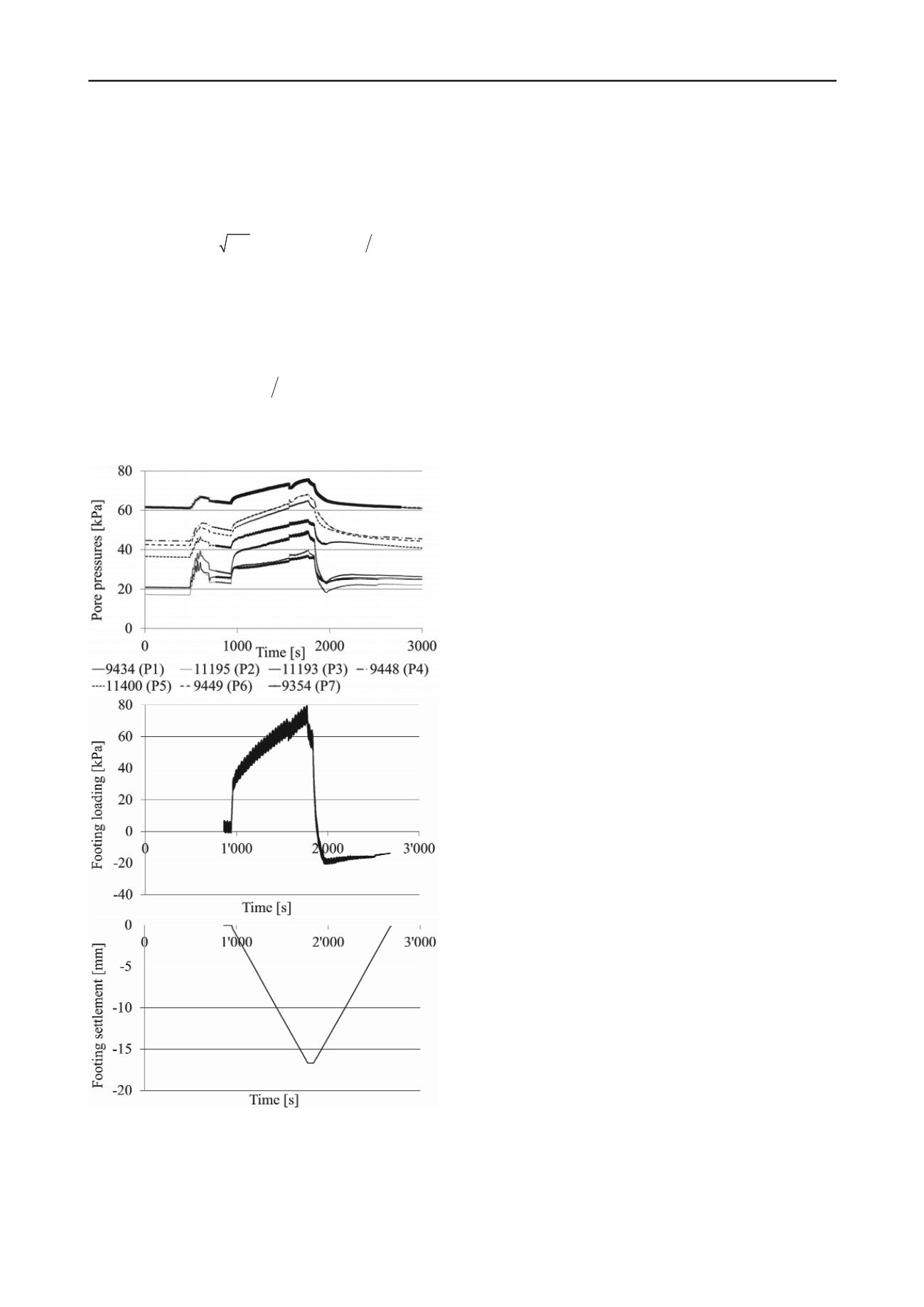
918
Proceedings of the 18
th
International Conference on Soil Mechanics and Geotechnical Engineering, Paris 2013
where A corresponds to the area and the indices “v” and “sc” to
vertical and stone column, respectively. The load on the stone
column when the jump was observed, for a global loading of 65
kPa, is then derived to be
234.2
sc
kPa
.
Bergado et al. (1994) suggest the bulging failure load (Muir
Wood et al., 2000) on a stone column is calculated from:
'
'
max
,
,
0
.
2
1 sin 1 sin
c
p c
u
p c
p c
s
s
q
z K s K q K
(3)
where
γ
c
is the unit weight of clay, z is the depth, K
p,c
is the
clay coefficient of passive earth failure, s
u
is the undrained shear
strength, q
0
is the overburden pressure and
�
’
s
is the angle of
friction of the column material. A failure load of
can be obtained.
max
269.6
q
kPa
Hughes & Withers (1974) propose a different equation to
calculate the bulging failure load:
'
max
4 1 sin 1 sin
c
u
s
q
z
s
'
s
kPa
(4)
where the nomenclature used is the same as in the formula of
Bergado et al. (1994). In this case, a failure load of
is obtained.
max
209.8
q
Fig. 7: (a) Pore water pressures, (b) footing loading and (c) footing
settlement during the footing loading.
It can be seen that the two theoretical solutions proposed
bound the value calculated from the data. As a consequence, it
may be concluded that local bulging failure in the stone
columns triggered an additional radial loading of the soft clay
and caused a small load decrement below the column (marked
by the pore water pressure drop observed at P7, which
subsequently consolidated out exponentially).
The local bulging failure described by Muir Wood et al.
(2000) replicates the case of an axially loaded cylindrical
specimen in a triaxial apparatus, in which shear discontinuities
are formed as sections of the cylindrical specimen spall
outwards from the central axis (Desrues et al., 1996).
7 SUMMARY
Data from a physical model test in a geotechnical centrifuge is
provided in this contribution to validate numerical processes to
simulate the installation effects of stone columns and their
subsequent use as ground improvement under a footing. Pore
pressure transducers have been installed in the vicinity and
under the stone column in this axisymmetric test. This
measurement provides valuable insight in the behaviour of the
stone columns. These measurements enable the identification of
the bulging failure load of the column, which lay between
boundaries given by two analytical solutions.
8 ACKNOWLEDGEMENTS
The fourth author was supported by a grant from the Brazilian
Research Council CNPq and funds from the ETH Rectorate and
the Department of Civil, Environmental and Geomatic
Engineering, during a two month stay (January-February 2012)
at ETH Zurich. This support is gratefully acknowledged.
(a)
P7
P4
9 REFERENCES
Adam. D. 2011. Bodenverbesserung versus Hybridgründung und
Tieffundierung – Vergleich der Gründungskonzepte von drei
Projekten mit Tragweite für Europa.
Institut für Geotechnik, ETH
Zürich, Kolloquium, 17.11.2011,
Bergado, D.T., Chai, J.C., Alfaro, M.C. and Balasubramaniam, A.S.
1994.
Improvement Techniques of Soft Ground in Subsiding and
Lowland Environment.
Balkema, Rotterdam.
Buchheister, J. 2009.
Verflüssigungspotential von reinem und siltigem
Sand unter multiaxialer Belastung
. Institut für Geotechnik, ETH
Zürich, Diss. Nr. 18312, VDF-Verlag, ETH Zürich
Desrues, J., Chambon, R., Mokni, M. and Mazerolle, F. 1996. Void
ratio evolution inside shear bands in triaxial sand specimens studied
by computed tomography.
Géotechnique
46 (3), 529-546.
Hansbo, S. 1981. Consolidation of fine-grained soils by prefabricated
drains.
X ICSMFE, Stockholm, Sweden
(3), 677-682.
Hughes, J.M.O. and Withers, N.J. 1974. Reinforcing of soft cohesive
soils with stone columns.
Ground Engineering
7 (3), 42-49.
Muir Wood, D., Hu, W. and Nash, D.F.T. 2000. Group effects in stone
column foundations model tests.
Géotechnique
50 (6), 689-698.
Schofield, A.N. 1980. Cambridge geotechnical centrifuge operations:
20th Rankine lecture.
Géotechnique.
30 (2), 129-170.
Springman, S., Laue, J., Boyle, R., White, J. and Zweidler, A. 2001. The
ETH Zurich Geotechnical Drum Centrifuge.
International Journal
of Physical Modelling in Geotechnics
1 (1), 59-70.
Stewart, D.P. and Randolph, M.F. 1991
.
A new site investigation tool
for the centrifuge.
Centrifuge ’91, H.Y. Ko and F.G. McLean (eds).
Balkema
, 531-537.
Weber, T.M. 2008.
Modellierung der Baugrundverbesserung mit
Schottersäulen.
Institut für Geotechnik, ETH Zürich, Diss. Nr.
17321, VDF-Verlag, ETH Zürich.
P3
P5
P6
P2 P1
(b)
(c)


